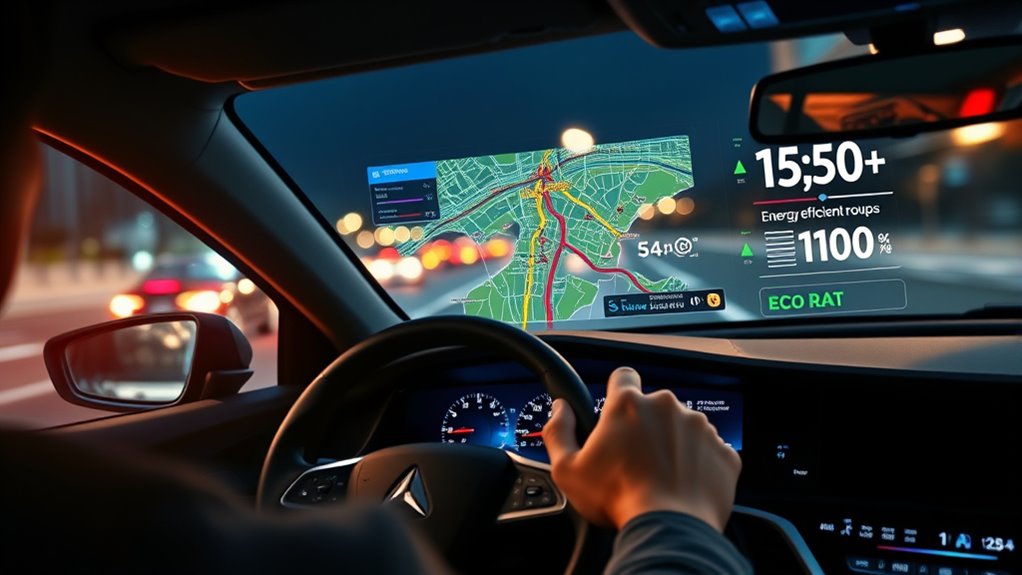Real-time telematics helps you optimize energy use by providing immediate insights into your driving habits. It flags aggressive behaviors like sudden braking or idling, allowing you to adjust on the spot. By integrating with analytics, you get tailored feedback and route suggestions that save fuel and reduce waste. Plus, you can track your performance over time for continuous improvement. Keep exploring how these tools can make your energy management smarter and more effective.
Key Takeaways
- Real-time data enables immediate detection of inefficient driving behaviors like idling or harsh braking.
- Telematics systems provide instant alerts to drivers, encouraging immediate corrective actions.
- Dynamic route optimization reduces energy waste by adjusting for traffic, weather, and road conditions in real time.
- Continuous monitoring offers insights for targeted driver coaching to improve energy-efficient habits.
- Integration with predictive analytics helps anticipate maintenance needs, preventing energy loss from vehicle inefficiencies.

Real-time monitoring allows you to observe and respond to data as it happens, enabling quicker decision-making and enhanced operational efficiency. When it comes to managing energy use in your fleet, this capability becomes especially valuable. By tracking driver behavior in real time, you gain immediate insights into how your drivers operate, which directly impacts fuel consumption and overall energy efficiency. For instance, aggressive acceleration, sudden braking, or idling can all drain fuel and waste energy. With continuous monitoring, you can identify these behaviors promptly and address them before they lead to costly exhaustive inefficiencies.
Real-time driver behavior monitoring boosts energy efficiency and prevents costly fuel waste.
Additionally, integrating telematics with vetted technology ensures your data collection is reliable and accurate. Telematics systems leverage predictive analytics to analyze driver patterns and predict future behavior. This proactive approach helps you implement targeted training or coaching, encouraging safer and more efficient driving habits. Over time, you’ll notice improvements in energy use as drivers adapt to feedback derived from real-time data. Predictive analytics also assists in identifying potential issues before they escalate, such as engine inefficiencies or maintenance needs, allowing you to schedule repairs proactively and keep your fleet operating at peak efficiency.
The beauty of real-time monitoring is that it transforms raw data into actionable insights. Instead of waiting for end-of-day reports, you can intervene instantly if you see a driver engaging in inefficient practices. For example, if a driver is consistently idling longer than necessary at loading docks, you can send a quick alert or message, prompting them to turn off the engine. This immediate feedback loop helps reduce unnecessary energy consumption and minimizes waste, ultimately saving you money.
Moreover, real-time data empowers you to optimize routes based on current conditions, such as traffic or weather updates. This dynamic routing minimizes fuel use and energy waste, especially during adverse conditions. It also allows you to set performance benchmarks, track progress over time, and reward drivers who demonstrate consistent efficiency. When drivers see their behavior directly influences fuel savings, they’re more motivated to maintain good habits.
In addition, integrating telematics with predictive analytics creates a thorough system that continuously learns and adapts. As more data is collected, your ability to forecast driver behavior and energy needs improves, leading to smarter decision-making. Over time, this results in a more energy-efficient fleet that operates smoothly and cost-effectively. Ultimately, real-time monitoring combined with predictive analytics gives you the tools to fine-tune your operations, promote responsible driver behavior, and optimize energy use—all essential for reducing costs and your environmental footprint.
Frequently Asked Questions
How Secure Is My Data With Telematics Systems?
Your data with telematics systems is generally secure, thanks to strong cybersecurity measures employed by providers. They use encryption, secure servers, and regular updates to protect your data privacy. While no system is completely invulnerable, reputable telematics companies prioritize security, so you can trust that your information is safeguarded against unauthorized access. Always review the provider’s security policies to stay informed about how your data is protected.
Can Telematics Improve Driving Behavior Instantly?
Ever wonder if telematics can change your driving instantly? Yes, it can! Real-time feedback helps you see your driving habits as they happen, encouraging safer, more fuel-efficient behavior right away. By monitoring acceleration, braking, and speed, telematics instantly highlights areas for improvement. This immediate insight motivates you to adopt better driving habits on the spot, leading to more efficient energy use and safer roads.
What Is the Cost of Implementing Telematics Technology?
Implementing telematics technology costs vary depending on fleet size and features, but you should consider expenses for hardware, software, installation, and ongoing support. These costs are offset by savings through improved fleet maintenance, reduced fuel consumption, and better driver training. Investing in telematics helps you optimize energy use, extend vehicle lifespan, and enhance safety. Over time, these benefits outweigh initial investments, making telematics a smart choice for your fleet.
How Does Telematics Affect Insurance Premiums?
Telematics can lower your insurance premiums by providing accurate data on your driving habits, like speed and braking, which insurers use to assess risk. However, you might face privacy concerns since your driving data is constantly monitored. Ensuring data accuracy is essential, as incorrect information could negatively impact your rates. Overall, telematics encourages safer driving and can lead to cost savings, but weigh privacy concerns carefully.
Are Telematics Systems Compatible With All Vehicle Types?
You’ll find that telematics systems are generally compatible with most vehicle types, thanks to flexible vehicle compatibility options. They integrate smoothly with various vehicle systems through specialized hardware or apps. Before installing, check system integration requirements and vehicle compatibility to guarantee proper functionality. Some older or unique vehicle models may need tailored solutions, so consulting with providers helps confirm compatibility and seamless integration for ideal energy management and performance.
Conclusion
By harnessing telematics for real-time monitoring, you can stay ahead of the curve and make smarter energy choices on the road. It’s a game-changer that turns data into actionable insights, helping you cut costs and reduce your carbon footprint. Remember, it’s better to be safe than sorry, so don’t wait until it’s too late. Embrace these tools now, and you’ll find that staying efficient isn’t just a goal—it’s a journey you’re already on.









